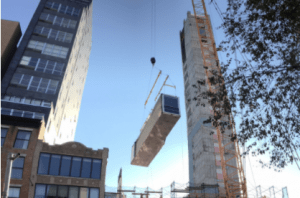FASTER, STRONGER, SMARTER: HOW PERMANENT MODULAR CONSTRUCTION PROJECTS GET BUILT
Much like traditional construction, modular construction projects can take many forms. Hotels, schools, hospitals, restaurants--all of these buildings can be created using modular construction methods. But unlike traditional on-site construction, the designs and plans for modular buildings are finalized well before assembly begins, allowing for an efficient off-site building and delivery process.
Whereas typical on-site construction projects tend to have a more fluid process that often includes change orders and the high potential for delay, there are various modular-specific methods that architects, builders, contractors, and other stakeholders all use to design and deliver modular buildings. Indeed, these time-saving methods and certainty of costs are key advantages of modular construction.
 Below are the six most common methods of modular building design and delivery.
Below are the six most common methods of modular building design and delivery.
Design-Bid-Build (DBB)
This is the most common and frequently used project delivery method with which most owners are acquainted. It is a linear process where all tasks are dependent on each other; design is followed by bidding and bidding is followed by construction with no overlap. Using this method, the owner selects an architect or engineer to prepare the working drawings, specifications, contract agreement forms and bidding information. Then, through a competitive bid or negotiated bid process, a contractor is selected to build the project. Any qualified bidder can take part in the competitive bid process; whereas only pre-qualified or pre-selected contractors can participate in the negotiated bid process. Selection is based on a combination of price and technical merit.
Once the project has been awarded, direct contractual agreements are formed between the owner and general contractor. The general contractor forms its own contracts with subcontractors to construct various specialized parts of the project. Open communication and team effort among all parties are essential for this method if the project is to be successful.
Design-Build (DB)
When the owner contracts with a single firm for both design and construction services, this is referred to as the design-build project delivery method. The DB team can be a single firm, a joint venture between a contractor and designer, a contractor with a designer as a consultant, or a design firm with a contractor as a consultant.
The financing and site are provided by the owner, who may also take responsibility for additional preliminary development costs. The contractor and architect are jointly hired by the owner to deliver a complete project. The DB team performs the complete design of the project based on a preliminary design or scope of work provided by the owner. The contractor then receives proposals and awards subcontracts to subcontractors. Once the design of the project is underway, the DB team can also start and coordinate the construction process.
There is a considerable reduction in cost and schedule in this method compared to DBB method because the design and construction phases can be overlapped. This is called fast-tracking. For example, the site work and structure for a project may begin soon after the structural design is completed, while at the same time the mechanical, electrical and plumbing design is being done. Figure 2 shows the relationships in this type of contractual arrangement.
Construction Management at Risk (CMR)
In this method, the owner selects the architect/engineer and the Construction Manager at Risk (CMR) based upon qualification and fee prior to design being completed or possibly started. The CMR acts like a general contractor in that it guarantees performance and completion of the project for a negotiated price, which is usually established when the design is 50% - 90% complete. The CMR also provides preconstruction services such as schedule, estimate, value engineering, constructability, and contract management assistance during the planning and design phase.
This method is also similar to the Design-Build method because the CMR can bid and subcontract portions of the completed and approved parts of the design while other parts of the project design are still being completed. Once the design moves to the field, the CMR is responsible for monitoring costs, quality and schedule performance. Figure 3 shows the relationships in this type of contractual arrangement.
Bid-Design-Build (BDB)
This is the project delivery method primarily used in the modular construction industry. With this method, the owner contacts a modular construction company directly and requests prices based on schematic and performance requirements of the project. This is done through front line sales professionals who help identify the owner’s needs by gathering all of the relevant information necessary to help make proper design choices. Then design considerations such as code compliance, budget, occupancy date, program requirements, and sustainability are reviewed.
Then the additional project elements of site preparation, foundations, transportation of modules to the site, setting and finish, utility hook-ups, and site restoration are discussed, often with a project manager along with the sales professional. The sales professional will then put together a proposal with a clearly defined scope of work that reflects the services the modular construction company can provide. If the owner accepts the proposal, then the project moves toward the design and construction phases.
What, when, and by whom the design professionals are engaged will depend on the project requirements and the project delivery method chosen. However, because the site can be prepped at the same time as the modular units are being constructed in the factory, the Design-Build delivery method can be advantageous. Figure 5 illustrates one scenario of the bid-design-build contractual relationship. Another scenario would have the design-team integrated with the modular construction company.
This is an online exclusive article.
